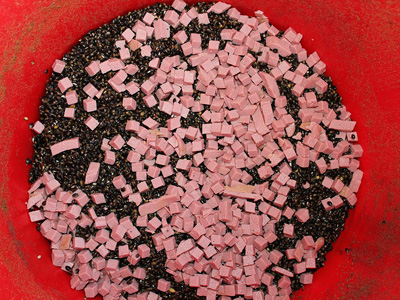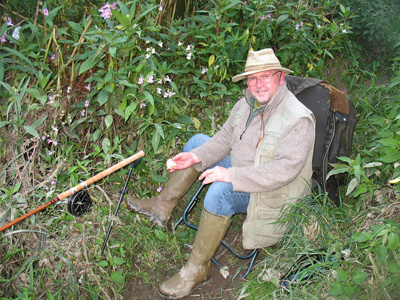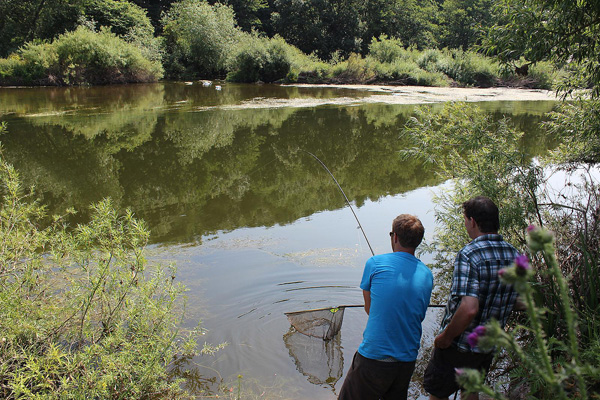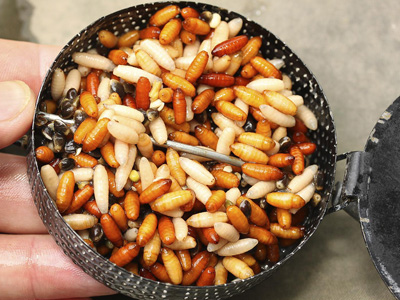We are now well into the close season and as I would no doubt be labelled as some kind of charlatan if I was fishing on a canal or a lake, I thought it best to focus on something far less controversial!
Ian, our esteemed editor, invited questions and he received an excellent response, so this time out I will give my personal slant on some of the queries raised, and hope that it helps not only those who posed the original question, but anyone who has an interest in barbel fishing.
So let’s kick off straight away with the first one:
Given your many years on the rivers fishing for barbel, what would you say is the one bait that has consistently out-fished all others for both summer and winter?
Luncheon meat is my answer and I’ll tell you why. From the wording of the question I’m basing this on longevity and versatility; it has certainly stood the test of time. The only other bait that comes close would be the humble maggot and I’ll take the liberty of including casters with that one as well as they are one and the same – well, almost!
But from those days fifty years ago when I was catching my first barbel on a piece of ‘Unox’, up to the modern day where ‘Garlic Spam’ is number one, barbel populations from one end of the country to the other still like to see good old PLM on the menu – even though the angling equivalent of the celebrity chef has brought all manner of wonderful gastronomic delights to their table!
If you cast a standard size cube out into the middle of the river on a hot summer’s day then you would probably not be doing yourself any favours but, with a little more thought, that very same bait presented in a different manner could work as well as any pellet. Moving it for example, trundling or rolling as we like to call it, would probably be the best option in that situation but there is another way of transforming a static solitary bait into a particle.
 My great friend Fred Crouch liked to fish meat in this particular way, he was always one to look for the most economical solution, and he devised a technique that at times would generate the same response from barbel as a gallon of maggots, but all for a few pints of hemp and a couple of tins of meat!
My great friend Fred Crouch liked to fish meat in this particular way, he was always one to look for the most economical solution, and he devised a technique that at times would generate the same response from barbel as a gallon of maggots, but all for a few pints of hemp and a couple of tins of meat!
The method is simplicity itself. The meat is cut into 3mm and 6mm cubes and mixed with five or six pints of hemp. It is then introduced via a bait dropper, preferably in a swim close to the near bank, and then it is left for a while as if you were fishing caster or maggot. The hook bait is usually a 6mm cube and I like to cut it in half and glue it together on the hair, just as I would attach flat pellets. I rarely see anyone these days fish this method and yet it works exceptionally well and is very cheap!
At the other end of the scale there is the huge hook bait, a 60mm cube of meat – sometimes larger – and I can say that I was there when this technique came about but I take no credit whatsoever, that goes to another good friend, Lol Breakspear.
Twenty five years ago, or thereabouts, we were fishing the River Teme and catching lots of barbel, great fun but it was a struggle to locate anything larger than 7 or 8lb. Lawrence (Lol) set to work to solve the problem of how to be more selective and as he was local it was easy for him to put his experiments to the test. He produced drawings, much in the way an engineer would, and pronounced that a huge bait could easily be taken by a larger-sized barbel – and he was correct.
 The technique involved minimal resistance and the pick up when it came was totally different to what we all know as the typical ‘barbel bite’. Larger fish from the Teme soon started to show and the method also worked extremely well on the lower Severn and to this day it still sorts out the largest specimens from the middle river.
The technique involved minimal resistance and the pick up when it came was totally different to what we all know as the typical ‘barbel bite’. Larger fish from the Teme soon started to show and the method also worked extremely well on the lower Severn and to this day it still sorts out the largest specimens from the middle river.
If you have never tried this method it does require a certain leap of faith but once you have caught a larger than average barbel this way you will be a convert, I guarantee it.
Another advantage of meat is when the water is cold, it can be mashed into a soft paste, and fished straight on the hook tight to the near bank, and this often catches where a bog standard cube fails.
So far from being ‘yesterday’s’ bait, good old luncheon meat is every bit as relevant today as it’s ever been, ignore it and it will be your loss!
You don’t hear much about Ray Walton style rolling baits for barbel very much these days – is it still an effective method? And if it is why does nobody use it anymore?
Yes, it is still an effective method and there are a few reasons why people are not using it so much.
I caught my first barbel from the River Lea back in the early sixties rolling meat, sausage or cheese paste through the weed beds tight to the far bank, it was a great method and there was a good head of barbel, chub and roach that made for a great day’s fishing when you were fifteen years old.
Years later and I experienced superb days on both the Kennet and Royalty, the common denominator being a good head of fish and multiple catches were the norm. Today, barbel populations are, in general, not quite so prolific and rolling a bait all day can be extremely hard work. Many of those who were big fans back in the eighties are now a lot older and, like me, find it just too tiring! However, in February or March on a swollen river it can still be the best way to go, you will keep warm by staying on the move and are likely to pick up the fish that are themselves on the move. I can certainly see myself using the technique this coming season on stretches of the Wye as it is a great way to ‘map’ new venues and is a quick and effective way of finding fish, bearing in mind that the Wye holds big shoals and I would recommend that others who visit this wonderful barbel river do the same, I will guarantee excellent results!

I also think, rightly or wrongly, that there is an element of being ‘in vogue’ when it comes to specialist fishing, and to that end rolling meat isn’t the fashionable method it once was. Back in the early nineties you would see barbel aficionados decked out in full length Barbours, wide brimmed hats, bait pouches around the waist and rods and net held out like rifles as they patrolled the banks – it was akin to something from a spaghetti western, but times change! We have all aged and some of us have become lazy, it’s easier when you have all day to build a swim and let the barbel come to you!
Welchy reckons if you have to wait until dark to catch barbel you are not fishing well enough during the daytime – I think I have read Pete Reading saying essentially the same – I only seem to catch at dusk and into darkness – does that make me a crap angler?
And Welchy is absolutely correct in his assertion; whether that makes someone a ‘crap’ angler I could not possibly comment!
There are a number of different aspects to this interesting question.
I am from the camp that believes you either go out to catch your barbel during the hours of daylight – and these days that’s very much my style. Or, because of circumstance, you set your stall to catch after dark. The two are completely different and I don’t believe you can get the best results by mixing the two together.
 For me it’s a particle approach during the day and a larger, single bait over hemp after dark and into the night. I also believe that barbel instinctively move away from their daytime haunts once darkness falls and often don’t return until dawn, I came to this conclusion after spending many hours fishing all through the night on the Severn.
For me it’s a particle approach during the day and a larger, single bait over hemp after dark and into the night. I also believe that barbel instinctively move away from their daytime haunts once darkness falls and often don’t return until dawn, I came to this conclusion after spending many hours fishing all through the night on the Severn.
Basically that means to get the best after dark you should really be looking to ambush fish as they go foraging and that can mean being mobile and that’s not for the faint hearted.
There’s no doubt that it involves a lot of work and a lot of bait to get the barbel into feeding mode during the day but it works more often than not and if you return the next day at first light to the same swim you might be very surprised at what you can catch in that first hour – it can be just as good as when dusk falls. You have to be there though!
Many retired barbel anglers are able to make the best of the daytime fishing, those who are younger and have to work tend to make the most of nocturnal barbel fishing. So I think it comes down to personal circumstances more than anything, if you think about what you are doing barbel fishing during the day can be every bit as good as fishing after dark, better I would suggest. There are times though when no matter how hard you work the barbel simply refuse to feed during the day and the suicidal fish at dusk is your only chance, that fish then becomes a saviour! I like to look at those situations as being the odd occasion and so my mind-set is never in negative mode when I’m on the river at 5 or 6am. When the night shift arrive it’s time for me to go and wish them well in the comforting knowledge that I’ve usually had my fair share during the day!
I have more excellent questions to answer in my next diary and I’ll also be telling you about the Barbel Show and a few other barbel related topics as the new season approaches. See you soon.










